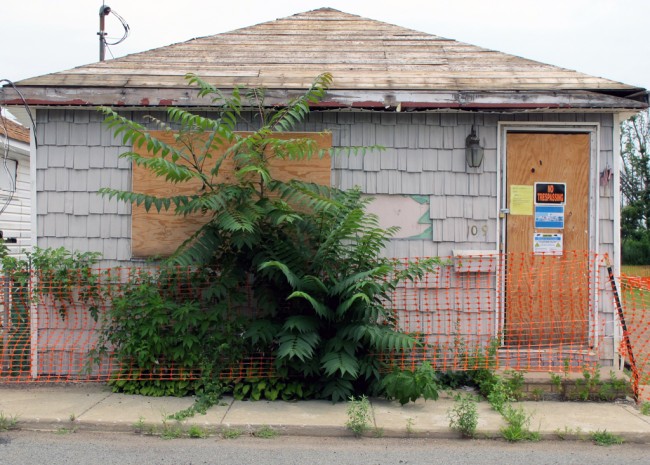As I have shown in my earlier science posts, sea level rise is one of the biggest challenges New York City will face due to climate change. The storm surge of Hurricane Sandy made it clear that the city was not equipped against floods caused by extreme weather events. In earlier posts two options were explained, a “soft” approach – beach nourishment – and a “hard” approach – barriers. In this post we will discuss retreat, the option left when nothing else will work.
Retreat is the act of moving away from the shoreline. Residents are encouraged to sell their land and then the government allows the land to return to its natural state. The option was discussed in Gornitz et al.’s 2002 paper Impacts of Climate Change on NYC Coasts. In Storm Surge, Sobel mentions a similar plan in the Netherlands. “Return to the River” forced residents, who were mostly farmers, to leave an area, which was then returned to a floodplain. A few negotiated to stay in the area, but the majority left.
After Hurricane Sandy, it became even clearer that retreat would be necessary. While Bloomberg said that retreat was not an option (Revkin 2013), Governor Cuomo signed off on the purchase of three neighborhoods in Staten Island, Oakwood Beach, Ocean Breeze, and Graham Beach, for retreat as part of the Hazard Mitigation Grant Program. These neighborhoods had almost all of the residents agreeing to sell their homes, with a few holdouts (Rush 2015a). During his State of the State address, Cuomo said, “There are some parcels that Mother Nature owns […] She may only visit once every few years, but she owns the parcel and when she comes to visit, she visits” (Homeland Security News Wire 2013). Many other neighborhoods along the east coast of the island, all of which were hit very hard by the storm surge of Hurricane Sandy, wanted to get in on the buyout, but a representative of Cuomo said the governor would not authorize the purchase of the entirety of the coast. The purchased neighborhoods have already begun to be demolished and reestablished as wetlands. The land would be planted with native grasses and retention pools would be built to capture the rainwater. The process cannot be completed until all residents leave. A large section of one neighborhood is currently owned by a developer who is holding out on selling the land, which poses a problem for the reestablishment (Rush 2015b).

There are other options for homeowners who want to relocate. “Build It Back” is a program which offers to pay for repairs or elevation of homes hurt by Hurricane Sandy. An acquisition program run alongside “Build It Back” offers to purchase homes on their own instead of a neighborhood buyout. The difference between this type of purchase and a group buyout is that individual purchases do not get returned to nature, instead they are redeveloped and new structures are built. This is not as good of a plan as retreat. Most of the areas that become severely flooded during storms used to be wetlands and were backfilled to make room for buildings. More than half the people who died during Hurricane Sandy lived in areas that used to be wetlands (Rush 2015a). Rebuilding on these areas could increase the number of fatalities in the future.
Retreat, though the severest choice in the fight for the coast, is the safest option both for human life and wildlife. Beach nourishment and barriers both lead to erosion and damage the habitat of wildlife that lives in the area. They are also incredibly costly and though barriers can reduce flood levels, they still leave residents in danger from the water that makes it over the seawall. Retreat puts no one in danger and returns the land to its natural state. Wetlands will protect the coast from sea level rise and storm surges. They will serve as a buffer for nearby residents from the elements and also vice versa by stopping runoff from going directly into the ocean.
In the next, and final, science blog we will take a look at some of the invasive species I got to know during my visits to New York parks.
Bibliography:
Gornitz, V., S. Couch, and E. K. Hartig. 2002. Impact of sea level rise in the New York City metropolitan area. Global and Planetary Changes 32: 61-88.
Homeland Security News Wire. 2013. NY to buy, demolish beachfront homes, make way for storm buffers. Homeland Security News Wire. http://www.homelandsecuritynewswire.com/dr20130207-ny-to-buy-demolish-beachfront-homes-make-way-for-storm-buffers
Revkin, A. C. 2013. Can Cities Adjust to a Retreating Coastline. The New York Times. http://dotearth.blogs.nytimes.com/2013/08/22/can-cities-adjust-to-a-retreating-coastline/?_r=0
Rush, E. 2015a. As the Seas Rise: Managing retreat along New York City’s Coasts. New Republic. https://newrepublic.com/article/123182/managing-retreat-along-new-york-citys-coasts
Rush, E. 2015b. Leaving the Sea: Staten Islanders Experiment with Managed Retreat. The Architectural League’s Urban Omnibus The Culture of Citymaking. http://urbanomnibus.net/2015/02/leaving-the-sea-staten-islanders-experiment-with-managed-retreat/
Sobel, A. 2014. Storm Surge: Hurricane Sandy, Our Changing Climate, and Extreme Weather of the Past and Future. HarperCollins. New York, New York, USA.
Vinnitskaya, I. 2013. NY State’s Governor Cuomo’s Solution for Ravaged Homes in NYC’s Coastal Region. Arch Daily. http://www.archdaily.com/331154/governor-cuomos-solution-for-ravaged-homes-in-nycs-coastal-region/
Image: http://urbanomnibus.net/redux/wp-content/uploads/2015/02/FoxBeach011_resize-650×465.jpg

